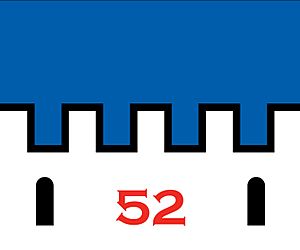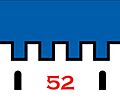52nd Infantry Brigade (United Kingdom) facts for kids
Quick facts for kids 52nd Infantry Brigade |
|
|---|---|

Modern Insignia of 52 Infantry Brigade, symbolising its role as the main formation in the city of Edinburgh Garrison.
|
|
| Active | World War I 1914 - 1918 World War II 1939 - 1945 1982 - 2010 |
| Country | United Kingdom |
| Branch | British Army |
| Type | Infantry |
| Role | Light infantry |
| Part of | 3rd Infantry Division |
| Garrison/HQ | Redford Barracks, Edinburgh |
| Engagements |
|
| Commanders | |
| Current commander |
Brigadier C.J. Lawrence MBE |
The 52nd Infantry Brigade was a special group of soldiers in the British Army. It was first created in 1914 as part of a large army called Kitchener's Army. This army was formed quickly to fight in World War I.
After the First World War, the brigade was stopped in 1919. But it was brought back during the Second World War in India. Later, it was active again from 1982 until 2010.
Contents
History of the Brigade
Fighting in World War I
The 52nd Infantry Brigade was first formed in September 1914. It was part of the 17th (Northern) Division. This division was a big group of soldiers. The brigade spent the entire war fighting on the Western Front. This was a major battle line in France and Belgium. The brigade was stopped in May 1919 after the war ended.
Units in World War I
During the First World War, several different army units were part of the 52nd Infantry Brigade. These included:
- 10th Battalion, Lancashire Fusiliers
- 12th Battalion, Manchester Regiment
- 9th Battalion, Duke of Wellington's (West Riding Regiment)
- 9th Battalion, Northumberland Fusiliers
- 3/4th Battalion, Queen's Own (Royal West Kent Regiment)
- 52nd Machine Gun Company
- 52nd Trench Mortar Battery
Fighting in World War II
The Brigade was started again in September 1943. This time, its job was to train soldiers for jungle warfare. This meant preparing them to fight in thick forests and hot, wet places. It helped get new soldiers ready for battle. In August 1945, it changed its name to Headquarters Training Group. It was then stopped completely, probably in 1946.
Units in World War II
Here are some of the units that were part of the brigade during the Second World War:
- 20th Battalion, Royal Fusiliers
- 7th Battalion, South Lancashire Regiment
- 12th Battalion, Sherwood Foresters
- 8th Battalion, York and Lancaster Regiment
The Brigade from 1982 to 2010
Older Connections
The more recent 52nd Infantry Brigade got its name from the 52nd (Lowland) Infantry Division. This was an older army division. It first went to Gallipoli during World War I. Then it moved to the Middle East. Finally, it went to the Western Front in March 1918.
In 1921, this division was reformed as part of the Territorial Army (T.A.). This was a group of part-time soldiers.
When the Second World War started in 1939, the division was sent to France. It was part of the British Expeditionary Force. Many soldiers from this force, including those from the 52nd Lowland Division, were evacuated from Dunkirk.
After that, the division trained in Britain. It learned how to fight in the air (airlanding) and in mountains. But in November 1944, it was sent to Europe as a regular infantry group. It fought in North-Western Europe until the end of the war.
The Territorial Army was reformed in 1947. It created the 51st/52nd Scottish Division. This division existed until 1967. In 1968, it split into two smaller groups. One was for the Highlands and the other for the Lowlands. The Lowland group was based near Glasgow.
The Latest Formation
The 52nd (Lowland) Brigade was formed again in 1982. It was created from the Lowland District group. It included two battalions of the 52nd Lowland Volunteers. It also had other Territorial Army units in the Scottish Lowlands.
On April 1, 2002, the brigade changed its name to 52 Infantry Brigade. It took control of regular army units in Scotland and North West England. It gave up its local and Territorial Army duties to another group, the 51 Scottish Brigade.
This change allowed the 52nd Infantry Brigade to focus on preparing regular army battalions for missions. On April 1, 2007, it joined the 3rd (UK) Division. The brigade was sent on one major mission to Afghanistan in 2007/08.
Operation Herrick VII
In November 2006, it was planned that the 52 Infantry Brigade would go to Afghanistan. This mission was called Operation Herrick VII. Brigadier Andrew Mackay was in charge of the brigade at this time.
In July 2007, the Ministry of Defence announced the brigade would lead the UK forces in Afghanistan. They served there from September 7, 2007, to March 8, 2008. Another brigade took over from them in spring 2008.
During their time in Afghanistan, the brigade successfully retook the important area of Musa Qala. This area had been controlled by the Taliban. Brigadier MacKay was later recognized for his excellent work.
The brigade faced many challenges during this operation. Some soldiers sadly lost their lives while serving.
Units in 2007
In 2007, the 52nd Infantry Brigade had its main offices in Redford Barracks and Edinburgh Castle. It included these units:
- 52 Infantry Brigade Headquarters and Signal Squadron
- 1st Battalion, The Rifles (Light Role Support Infantry Battalion) - Edinburgh
- 3rd Battalion, The Rifles (Light Role Infantry Battalion) - Redford Barracks
- 2nd Battalion, Royal Gurkha Rifles (Light Role Infantry Battalion) - Sir John Moore Barracks
- 2nd Battalion, Yorkshire Regiment (Light Role Infantry Battalion) - Weeton Barracks
- 2nd (Royal Highland Fusiliers) Battalion, Royal Regiment of Scotland (Light Role Infantry Battalion) - Edinburgh
End of the Brigade
After returning from Afghanistan, the brigade went back to its regular duties. This included training and being part of the Edinburgh Tattoo. The main offices of the 52 Infantry Brigade were at Redford Barracks in Edinburgh. Some other offices were at Edinburgh Castle.
The 52nd Infantry Brigade no longer exists. It was officially stopped in 2010 as part of a new plan for the army called Army 2020.
Images for kids


